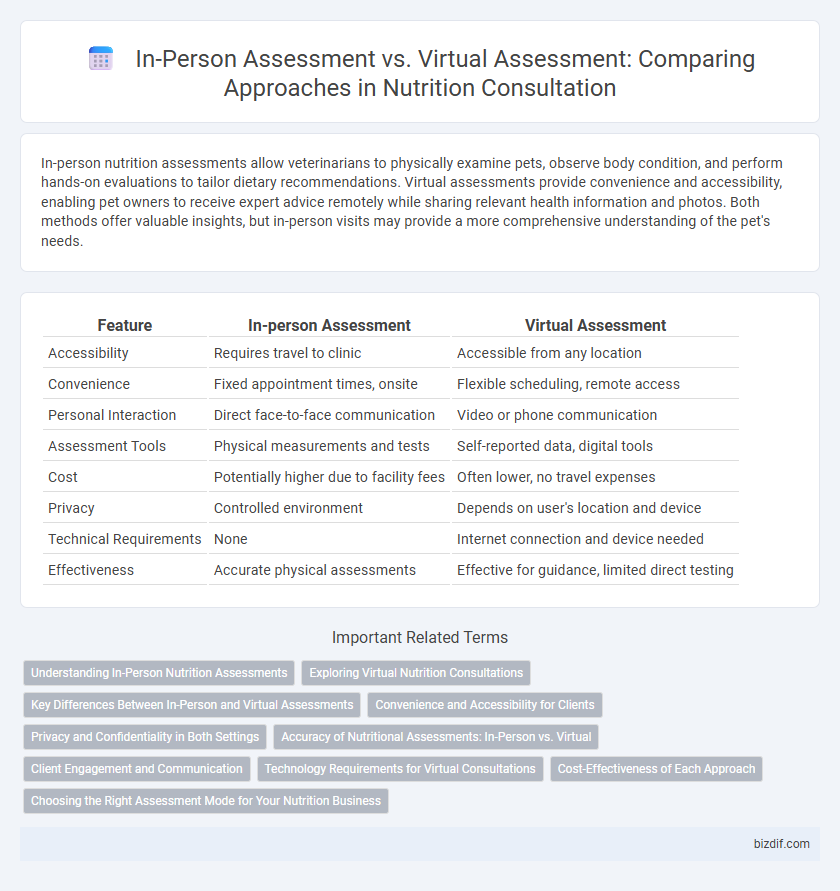In-person nutrition assessments allow veterinarians to physically examine pets, observe body condition, and perform hands-on evaluations to tailor dietary recommendations. Virtual assessments provide convenience and accessibility, enabling pet owners to receive expert advice remotely while sharing relevant health information and photos. Both methods offer valuable insights, but in-person visits may provide a more comprehensive understanding of the pet's needs.
Table of Comparison
| Feature | In-person Assessment | Virtual Assessment |
|---|---|---|
| Accessibility | Requires travel to clinic | Accessible from any location |
| Convenience | Fixed appointment times, onsite | Flexible scheduling, remote access |
| Personal Interaction | Direct face-to-face communication | Video or phone communication |
| Assessment Tools | Physical measurements and tests | Self-reported data, digital tools |
| Cost | Potentially higher due to facility fees | Often lower, no travel expenses |
| Privacy | Controlled environment | Depends on user's location and device |
| Technical Requirements | None | Internet connection and device needed |
| Effectiveness | Accurate physical assessments | Effective for guidance, limited direct testing |
Understanding In-Person Nutrition Assessments
In-person nutrition assessments provide direct interaction allowing dietitians to perform physical measurements such as body composition analysis and observe non-verbal cues that enhance personalized dietary recommendations. These assessments facilitate real-time clarification of nutrition goals and immediate adjustment of meal plans based on physical examination findings. The tactile and observational data gathered during face-to-face sessions contribute to a more comprehensive understanding of a patient's nutritional status compared to virtual assessments.
Exploring Virtual Nutrition Consultations
Virtual nutrition consultations leverage advanced video conferencing tools to provide personalized dietary assessments and tailored meal plans without geographical limitations. These remote sessions enable real-time interaction, nutrient tracking, and progress monitoring through integrated apps, enhancing client engagement and adherence. Virtual platforms also facilitate access to registered dietitians and nutrition experts, broadening opportunities for specialized support in diverse health conditions.
Key Differences Between In-Person and Virtual Assessments
In-person nutrition assessments provide direct physical measurements and immediate non-verbal communication cues, enhancing accuracy and personalized care. Virtual assessments offer convenience and accessibility, utilizing digital tools to track dietary habits and progress remotely. Both methods require tailored approaches to ensure effective client engagement and accurate data collection.
Convenience and Accessibility for Clients
In-person nutrition assessments offer personalized, hands-on evaluations that allow practitioners to closely observe physical cues and conduct comprehensive measurements. Virtual assessments provide unmatched convenience and accessibility, enabling clients to receive expert guidance from any location without travel constraints. Both methods increase client engagement by accommodating diverse schedules and preferences, optimizing the overall nutrition consultation experience.
Privacy and Confidentiality in Both Settings
In-person nutrition consultations offer controlled environments that enhance privacy by minimizing digital data breaches and ensuring confidential discussions within private office spaces. Virtual assessments rely on secure, encrypted platforms to protect client information but face challenges such as potential cyber threats and maintaining confidentiality over network connections. Both settings require strict adherence to data protection laws like HIPAA to uphold client trust and confidentiality effectively.
Accuracy of Nutritional Assessments: In-Person vs. Virtual
In-person nutritional assessments offer higher accuracy due to direct physical measurements and real-time observation, enabling precise evaluation of body composition and dietary habits. Virtual assessments rely on self-reported data and video consultations, which can introduce reporting biases and limit the scope of physical examination. Despite technological advancements, in-person assessments remain the gold standard for accurate nutritional evaluation and personalized intervention planning.
Client Engagement and Communication
In-person nutrition assessments foster stronger client engagement through direct eye contact, body language, and immediate feedback, enhancing trust and rapport. Virtual assessments leverage video and digital tools to maintain communication flexibility, though may encounter challenges in interpreting non-verbal cues. Tailoring interaction methods to individual client preferences maximizes effective communication and nutrition outcomes.
Technology Requirements for Virtual Consultations
Virtual nutrition consultations require reliable high-speed internet, a device with a camera and microphone, and secure video conferencing software to ensure clear communication and confidentiality. In-person assessments eliminate the need for technology but require a physical location and appointment scheduling. Efficient virtual consultations depend on user-friendly platforms compatible with various devices, enabling seamless interaction and real-time data sharing.
Cost-Effectiveness of Each Approach
In-person nutrition assessments typically incur higher costs due to facility fees, travel expenses, and extended appointment durations, whereas virtual assessments reduce overhead by eliminating travel and allowing for shorter, more flexible consultations. Virtual assessments often deliver comparable nutritional guidance through telehealth platforms, enhancing cost-effectiveness for both providers and patients by maximizing accessibility and minimizing time investment. Evaluating insurance coverage and technological requirements further influences the overall affordability and practicality of each assessment method.
Choosing the Right Assessment Mode for Your Nutrition Business
Selecting the appropriate assessment mode for your nutrition business depends on factors like client accessibility, technological capabilities, and the need for personalized interaction. In-person assessments allow for comprehensive physical evaluations and immediate rapport-building, essential for clients requiring hands-on support or who prefer direct contact. Virtual assessments offer flexibility and convenience, enabling broader reach and consistent follow-ups, making them ideal for tech-savvy clients or locations with limited access to nutrition professionals.
In-person Assessment vs Virtual Assessment Infographic

 bizdif.com
bizdif.com